Liberty Belle (aircraft)
Liberty Belle was a popular moniker with over two dozen known individual Boeing B-17 Flying Fortresses and Consolidated B-24 Liberators using the name in combat during World War II.
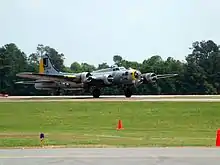
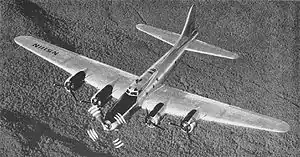
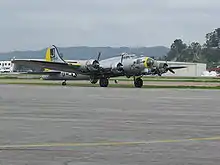
.jpg.webp)
The combat Liberty Belles were commemorated by two B-17s which used the name, with one still remaining as a static display: Miss Liberty Belle (44-83690) is displayed at the Grissom Air Museum. The Liberty Foundation flew a composite B-17 named Liberty Belle (constructed from two damaged aircraft (non-combat 44-85734 and the rear part of 44-85813) as a warbird from 2004 until 2011, when it was destroyed in a fire after an emergency landing. It is currently under rebuild at the Brooks Aviation Center in Douglas, Georgia.[2][3]
Commemorative Liberty Belle B-17
The Boeing B-17(SN 44-85734)[4] did not see combat in World War II, and was originally sold on 25 June 1947, as scrap to Esperado Mining Co. of Altus, Oklahoma; it was then sold again later that year for $2,700 to Pratt & Whitney, which operated the B-17 as a heavily modified test bed[1] (similar to 44-85747 and 44-85813).[5] Following these flights, it was donated to the Connecticut Aeronautical Historic Association, where a tornado on 3 October 1979, blew another aircraft onto the B-17's midsection, breaking the fuselage.
The B-17 was eventually purchased by aviation enthusiast Don Brooks, who formed the Liberty Foundation to exhibit the plane as the Liberty Belle. Restoration began in 1992 with parts from another damaged B-17 (44-85813), performed by Tom Reilly and company/Flying Tigers Warbird Restoration Museum (aka "Bombertown USA"), located at that time at Kissimmee Gateway field, Kissimmee, Florida. She returned to the air on 8 December 2004, and had been touring the air show circuit since then. The Liberty Foundation also planned an historic overseas tour in July 2008 along the northern ferry route to England.
On the morning of 13 June 2011, Liberty Belle made a forced landing in Oswego, Illinois, after taking off from Aurora Municipal Airport in Sugar Grove, Illinois. Shortly after takeoff, the pilot of a T-6 Texan chase plane informed Liberty Belle's pilot that the B-17 inboard left wing was on fire and advised an immediate landing. The bomber landed successfully in a nearby field and the seven people aboard were able to evacuate without injury, but due to the muddy ground the fire engines could not reach it, allowing the fire to spread and destroy the plane.[6] The bomber's remains were stored in a hangar in Aurora for a few days before being taken back to its home at Brooks Aviation Inc in Douglas, Georgia. It is currently under rebuild, possibly to airworthy status, using the forward fuselage of another B-17 (44-83387)[7] and other new parts, but when the restoration will be completed is unknown.[8]
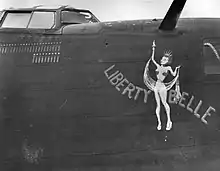
41-23920
The Liberty Belle (41-23920), a B-24D, was a member of the 90th Bombardment Group, 321st Bombardment Squadron. It operated from 5 Mile Drome (Wards Drome) near Port Moresby flying bombing missions over New Guinea. Afterwards, this bomber was flown back to the U.S. and finally scrapped at Stillwater, Minnesota.[9]
41-28970
The Liberty Belle (41-28970), a B-24H, was a member of the 461st Bombardment Group, 765th Bombardment Squadron. On 3 August 1944 during a bombing mission to Friedrichshafen, she was shot down over Belluno, Italy.[10]
42-29659
The Liberty Bell (42-29659), a B-17F, arrived at the Bassingbourn Airfield on 15 March 1943 as a member of the 91st Bombardment Group, 324th Bombardment Squadron. Just seven short days after arrival, on a mission over Wilhelmshafen the aircraft was hit by a bomb dropped from above by a Messerschmitt Bf 109 (Me 109) flown by Oberleutnant Heinz Knoke, and crashed into the North Sea 20 miles west of Heligoland with all ten crewman killed in action (KIA). In this action, Knoke thus became the first of only a few fighter pilots to successfully destroy an enemy aircraft by "bombing the bombers" (an experimental tactic that was soon abandoned by the Luftwaffe).[11]
42-30039
The Liberty Belle (42-30039), a B-17F (BQ-7 Aphrodite variant), arrived at the Grafton Underwood Airfield on 29 May 1943 as a member of the 384th Bombardment Group, 544th Bombardment Squadron. She was assigned to 12 missions, receiving combat credit for 3 of them. On 14 August 1943 she was transferred to the Little Staughton Airfield. In January 1944 she was again moved to the Knettishall Airfield and fitted as a BQ-7 variant for Operation Aphrodite. On 15 October 1944 during a mission against the Heligoland U-boat pens she "was hit by flak and crashed" and listed missing in action (MIA).
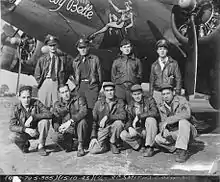
42-30096
The Liberty Belle (42-30096), a B-17F, arrived at the Greater Ashfield Airfield on 26 June 1943 as a member of the 385th Bombardment Group, 349th Bombardment Squadron. On her 19th mission, they were tasked as the lead of the Low Squadron. After climbing through a thick cloud layer and breaking out on top at about 19,000 feet, the pilot directed the engineer to fire a red flare as a signal for the rest of the squadron to form up on them. The M8 flare exploded igniting the gun kit box causing a secondary explosion. With the entire top turret in flames, a full load of fused 500-pounders and bundles of fire bombs the pilot immediately pushed the bail-out bell. The plane further exploded coming to rest in a field 1/2 mile west of Penlan Hall, Wakes Colne. Of the ten man crew, four were killed in action (KIA) including the fill-in co-pilot, navigator, bombardier and top turret gunner.[12]
42-30141
The Liberty Belle (42-30141), a B-17F, arrived at the Snetterton Airfield on 12 June 1943 as a member of the 96th Bombardment Group, 337th Bombardment Squadron. On 28 July 1943 it went missing in action (MIA) during a bombing run over Oschersleben. Of the eleven crewmen, only the bombardier survived. He was picked up by a German seaplane eight hours later and taken prisoner of war (POW). Aircraft wreckage and the bodies of six crewmen washed ashore along the North Sea coast weeks later.
42-30322
The Liberty Belle (42-30141), a B-17F, arrived at the Horham Airfield on 15 June 1943 as a member of the 95th Bombardment Group, 412th Bombardment Squadron. On 10 October 1943 she was severely damaged but limped home safely. On 18 May 1944 she was transferred to the Little Staughton Airfield and after again being severely damaged in battle she was salvaged on 23 June 1944.
42-30634
The Liberty Belle (42-30634), a B-17F, arrived at the Horham Airfield on 20 August 1943 as a member of the 305th Bombardment Group, 365th Bombardment Squadron. During her 30th mission on 21 February 1944 after taking flak she crashed in North Sea, two miles off coast at Egmond aan Zee, the Netherlands. Six crewman were killed in action, four were rescued by a Dutch fisherman and taken prisoners of war (POW).
42-31255
The Miss Liberty Belle (42-31255), a B-17G, arrived at the Chelveston Airfield on 4 December 1943 as a member of the 305th Bombardment Group, 356th Bombardment Squadron. During a mission on 3 August 1944 over Saarbrücken she took severe battle damage and crashed in Wymington, near Rushden, Northants England. Two crewman were wounded in action (WIA) and seven crewman were killed in action (KIA). Miss Liberty Belle, B-17G serial number 42-31255, flew 64 complete missions out of Cheveston, England, but was lost near the end of her 65th mission on August 3, 1944, when another B-17 with wounded crew aboard shot a flare and took priority for landing. Miss Liberty Belle, with severe engine damage, tried to go around, but lost power and crashed.
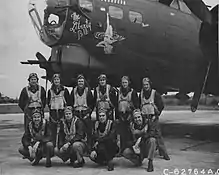
42-31610
The Liberty Belle (42-31610), a B-17G, arrived at the Bassingbourn Airfield on 2 January 1944 as a member of the 91st Bombardment Group, 322nd Bombardment Squadron, later moving to the 324th Bombardment Squadron. On 16 July 1944 while on a mission over Munich she took heavy flak which KO'd an engine and punctured gas tanks. It finally ditched in the English Channel and all nine crewman were rescued.[13][14]
42-37880
The Liberty Bell-E (42-37880), a B-17G, arrived at the Framlingham Airfield on 11 November 1943 as a member of the 390th Bombardment Group. During a mission on 25 February 1944 over Regensburg she took heavy enemy aircraft fire and crashed in La Racrute, Pierrepont, six miles southwest of Sedan, France. Six crewman were killed in action (KIA) and four were taken prisoners of war (POW).
42-40686
The Liberty Belle (42-40686), a XB-24D (converted B-24D), was a member of the 43rd Bombardment Group, 63rd Bombardment Squadron. On 30 November 1944 it took off on a night bombing mission over Bacuit Bay, Palawan. Spotted by a Japanese task force of cruisers and destroyers it was hit by anti-aircraft fire in one of the engines, forcing the bomber to head eastward towards Tacloban, the nearest Allied base. En route, a second engine failed. When the bomber arrived at Tacloban Airfield, the area was under Japanese air attack, and American gunners were firing. The pilot attempted a force landing with only two engines, but obstructions forced him to abort. During the second landing attempt, a white phosphorus bomb burst on the runway. He applied the brakes causing the nose wheel to blow out but the bomber landed without injury to the crew. The aircraft was abandoned at Tacloban Airfield in a swampy area at the north-western end of the airfield.[15]
42-40701
The Liberty Belle (42-40701), a B-24D, was a member of the 389th Bombardment Group, 412th Bombardment Squadron. For unknown reasons on 14 July 1943, two crew bailed out over Sicily but the plane landed safely. Both men were killed in action (KIA). Finally on 21 September 1943 it crash landed at Bizerte Airfield, Tunisia and was abandoned there, later being condemned 4 October 1943.[16]
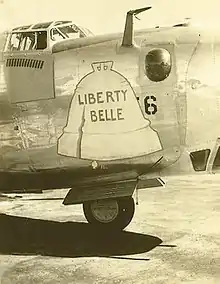
42-51134
The Liberty Belle (42-51134), a B-24H, arrived at the Horham Airfield and was a member of the 466th Bombardment Group, 784th Bombardment Squadron. It crashed on 1 September 1944.
42-5889
The Liberty Belle (42-5889), a B-17F, arrived at the Grafton Underwood Airfield on 23 June 1943 as a member of the 544th Bombardment Group, 384th Bombardment Squadron. On 22 August 1943 she was moved to Thurleigh Airfield and became a member of the 369th Bombardment Group, 306th Bombardment Squadron. While returning from a mission over the shipyards at Gdynia it crash landed at Matlaske Airfield overshooting the runway and coming to rest in the Barningham estate.
42-63714
The Liberty Belle (42-63714), a B-29, arrived in Guam in 1945 as member of the 315th Bombardment Wing, 501st Bombardment Group, 485th Bombardment Squadron.
42-7626
Originally named Ramblin' Okie and latter renamed the Liberty Belle (42-7626), this B-24H, was a member of the 392nd Bombardment Group, 578th Bombardment Squadron. On 13 December 1943 on a bombing run to Kiel, the crew had experienced engine trouble all the way in formation to the target. Just after ‘bombs away’ at the target, the pilot had to feather #3 engine, and after five minutes #4 engine had to be shut down due to loss of oil pressure. With two engines failed and after taking heavy damage by German pilot Hugo Feutscher in Ju 88C-6 it was forced to ditch in North Sea off Ameland, Netherlands.[17]
42-94996
The Liberty Bell (42-94996), a B-24, was a member of the 389th Bombardment Group, 755th Bombardment Squadron.
42-97849
The Liberty Bell (42-97849), a B-17G, arrived at the Framlingham Airfield on 27 May 1944 as a member of the 390th Bombardment Group, 570th Bombardment Squadron. On 14 February 1945 she was heavily damaged during an Oil Campaign raid, and had to make a forced landing in Belgium. Two crewman were killed in action (KIA) and one wounded in action (WIA).
42-100206
The Liberty Belle II (42-100206), a B-24J-80, was a member of the 22nd Bombardment Group, 2nd Bombardment Squadron. On October 10, 1944, the Liberty Belle II took off from Owi Airfield with a group B-24s from the fifth Air Force on an 18-hour round-trip bombing mission to the Pandansari refinery in Balikpapan, Borneo. During the bombing mission the Liberty Belle II was hit by enemy aircraft fire, and, due to the damage sustained, was later forced to crash land in a mangrove swamp on Batudaka island in Indonesia. Miraculously, there were no serious injuries. The crew of The Liberty Belle II were taken in, fed, and sheltered by the inhabitants of Batudaka island for several days until they could be rescued by U.S. forces. The crew included: Tandy O. Lofland II (radio operator/gunner), Harold Clover (gunner), Frank Zabielski (engineer/gunner), Glen Gregory (gunner), Edward Cespedes (gunner), Orlyn Due (gunner), Leo McDermott (navigator) Nixon Shrader (bombardier), Joe Tafaro (pilot).
43-37543
The Liberty Belle (43-37543), a B-17G, arrived at the Ridgewell Airfield on 4 June 1944 as a member of the 532nd Bombardment Squadron, 381st Bombardment Group. On 24 May 1945, 16 days after VE Day, it was transferred to the Deopham Green as a member of the 452nd Bombardment Group. It returned to the U.S., was assigned to Kingman, Arizona, on 17 December 1945 and eventually scrapped.
43-38301
The Liberty Belle (43-38301), a B-17G, arrived at the Glatton Airfield on 10 August 1944 as a member of the 751st Bombardment Squadron, 457th Bombardment Group. It returned to the U.S., was assigned to Kingman, Arizona, on 10 December 1945 and eventually scrapped.
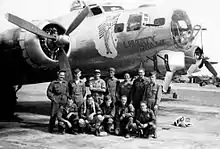
43-38037
The Liberty Belle (43-38037), a B-17G, arrived at the Lavenham Airfield on 27 May 1944 as a member of the 836th Bombardment Squadron, 487th Bombardment Group. It was involved in a mid-air collision with the B-17G “Heavenly Body” (43-38154) on 30 September 1944. After a sharp turn in heavy contrails, this B-17 was caught in prop wash (presumed), went over on its back and collided with Tail Number 43-38154 of the same squadron. The right wing of '38037 and the left wing of '38154 came off, and both aircraft crashed at Bexterhagen, 9 km east of Bielefeld. Only 3 out of 18 men on the two aircraft survived.[18]
44-40708
The Liberty Belle (44-40708) was a B-24-J assigned to the 819th Bombardment Squadron of the 30th Bomb Group. It flew out of Saipan from Aug 1944 until February 1945. First Crew was 1LT Arthur M. Knudson – Pilot – Minnesota,1LT Harry H. Halperin – Copilot – California, 1LT Edward J. Tivenan – Navigator – Massachusetts, 1LT Floyd B. McGuire – Bombardier – Iowa, T/SGT Patsy R. Puglio – Engineer/Waist Gunner – Pennsylvania, T/SGT John P. Breen – Radioman/Tail Gunner – Washington D.C., S/SGT Adelbert L. Laing Assistant Engineer/Top Turret – Texas, S/SGT Michael H. Martynec – Assistant Radioman/Ball Turret – New Jersey, S/SGT Michael J. Esposito – Armorer/Waist Gunner – Pennsylvania, SS/SGT John H. Mahoney – Armorer/Nose Turret – California. The crew completed their 40th mission on January 30, 1945. Primary targets were the Bonin and Volcano Islands, primarily Iwo Jima and Chichi Jima, and enemy vessels as a bomber and as a spotter for Naval Gunfire. Liberty Belle was most likely transferred to 11th BG after the fall of Iwo Jima when the 30th BG returned to Hawaii. Last photo of Liberty Belle (Okinawa?) shows 76 missions completed.
44-41234
The 1944 B-24J Liberty Belle (44-41234) flew 29 combat missions[19] in the 22nd Bomb Group (33rd Bomb Squadron),[20] while the B-29 Liberty Belle II (42-94045) was shot down[21] in the first bomb raid against Balikpapan,[22] after being in Herington, Kansas, during April 1945.[23]
44-50894
The Liberty Belle (44-50894), a B-24M, was a member of the 380th Bombardment Group, 529th Bombardment Squadron in Okinawa, Japan 1945

44-83690
The Miss Liberty Belle (44-83690), a B-17G, was assigned to the USAF as a drone director DB-17P, before being retired in 1958. It was on display at the Grissom Air Museum from 1961 to 2015, just outside the former Grissom Field in central Indiana (displayed 42-31255, Miss Liberty Belle of the 305th Bomb Group stationed at Chelveston, UK). The aircraft was moved to the Museum of Aviation at Warner Robins, Georgia, in 2015 for restoration.[24]
44-107211
The Liberty Belle (44-107211), a B-17G, was a member of the 100th Bombardment Group, 349th Bombardment Squadron. On 29 July 1944 it went missing having taken enemy fire over the oil refinery town and crashed in Mannstedt, Germany. The crew had bailed out, but were captured and most were killed by the town residents. Carl Gustafson (pilot), Mike Newmerowski (co-pilot), Vic Kinkade (navigator), Marcena Dottoviano (bombardier), Tony Trebnik (radio operator), Jack Kromer (ball turret gunner), Frank Caldwell (waist gunner) and Bill Ewing (tail gunner) were killed in action (KIA), and Bob Fife (flight engineer/top turret gunner) was wounded and taken prisoner of war (POW).
| External media | |
|---|---|
| Images | |
| Video | |
| Wikimedia Commons has media related to Liberty Belle. |
References
- Scott Rose, warbirdsresourcegroup.org. "Boeing B-17 Flying Fortress Registry – A Warbirds Resource Group Site". warbirdregistry.org. Retrieved 18 June 2012.
- "Miscellaneous B-17 Information". Retrieved 25 June 2016.
- "Restoring the Liberty Belle B-17". Northeast Pilots Group. May 18, 2012. Retrieved 25 June 2016.
- "1944 USAAF Serial Numbers (44-83886 to 44-92098)". Encyclopedia of American good Aircraft. Joseph F. Baugher. Archived from the original on 7 January 2009. Retrieved 3 March 2008.
- "American airplanes: Boeing A-B". Aerofiles.com. 14 February 2002. Retrieved 18 June 2012.
- Sarkauskas, Susan; Santana, Marco (14 June 2011). "Fire destroys WWII bomber in Oswego". Daily Herald. Paddock Publications, Inc. Retrieved 7 January 2018.
- "Miss Vilma and Liberty Belle". A2A Simulations. Retrieved 25 June 2016.
- "B-17s: Where to find them". Aero Vintage Books. Retrieved 25 June 2016.
- Taylan, Justin. "B-24D-13-CO "Liberty Belle" Serial Number 41-23920". Pacific Wrecks. Pacific Wrecks Inc. Retrieved 7 January 2018.
- http://www.lostaircraft.com/database.php?lang=en&mode=viewentry&e=22806#
- http://www.8thafhs.com
- http://www.385thbga.com/wp-content/uploads/Newsletter-Nov.-1978.pdf
- Baugher, Joseph F. (1 May 2011). "1942 USAAF Serial Numbers (42-30032 to 42-39757)". Encyclopedia of American Aircraft. JoeBaugher.com. Retrieved 23 May 2010.
30039 to 803rd BS(P) at [RAF] Oulton during early 1944 as radar countermeasures aircraft, fitted with Mandrel sets and nine carpet sets [for jamming]. (384th BG, 544th BS, *Liberty Belle*) to Aphrodite project and launched against U-boat pens on Heligoland 15 October 1944. In final mission, was hit by flak and crashed into sea short of target.
External link in|work=(help) - dailies of the 324th bomb squadron, 16 July 1944
- Taylan, Justin. "XB-24D "Liberty Belle" Serial Number 42-40686". Pacific Wrecks. Pacific Wrecks Inc. Retrieved 7 January 2018.
- Baugher, Joe (10 December 2017). "1942 USAAF Serial Numbers (42-39758 to 42-50026)". Retrieved 7 January 2018.
- http://www.lostaircraft.com/database.php?lang=en&mode=viewentry&e=18050#
- Hauenstein, Lee. "Photo History of the 487th Bomb Group (H)".
- History, Strange (29 May 2009). "Liberty Belle II | Flickr – Photo Sharing!". Flickr. Retrieved 18 June 2012.
- "1944 USAAF Serial Numbers". Joebaugher.com. Retrieved 18 June 2012.
- "Archived copy". Archived from the original on 3 December 2010. Retrieved 29 April 2011.CS1 maint: archived copy as title (link)
- "Balikpapan During World War II". Webspace.webring.com. Archived from the original on 21 September 2012. Retrieved 18 June 2012.
- Pete Weiler. "Crew 24, 61st Squadron – 39th Bomb Group (VH)". 39th.org. Retrieved 18 June 2012.
- "B-17G "Flying Fortress" Undergoing Restoration". Museum of Aviation. Museum of Aviation Foundation, Inc. Retrieved 7 January 2018.